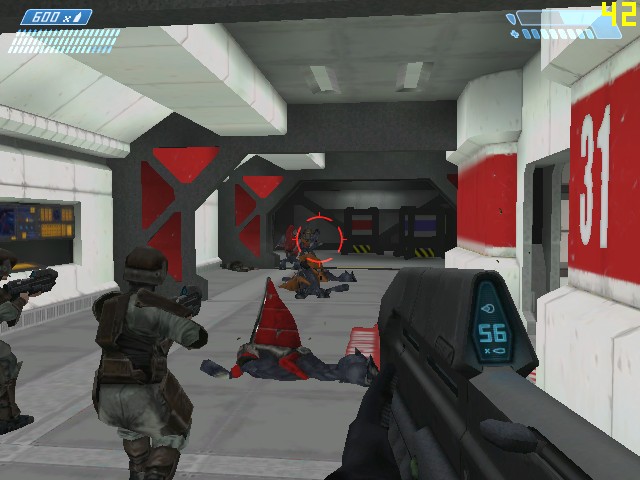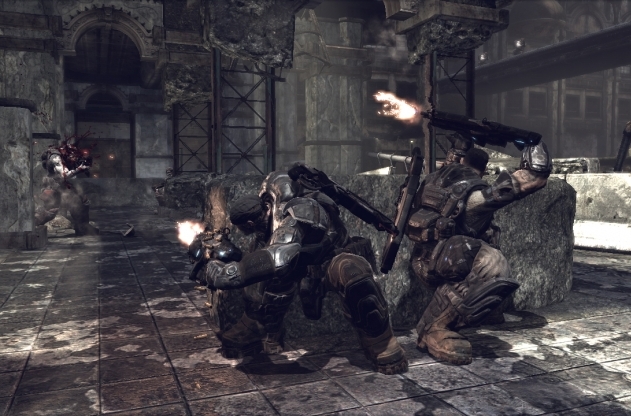Perspective defines perceived reality, which holds true for virtual realities. The lens through which the player experiences a game frames the action in a way that no graphical prowess or intriguing plot twist can. Shooters often demonstrate this relationship better than any genre with two distinct perspectives: first-person and third-person. This is more than a question of point-of-view; it’s a battle for shooter supremacy. Head 2 Head brings you the firefight that developers know all too well, First-Person Shooters vs. Third-Person Shooters.
*Note that there will be contradictions and exceptions to the generalities expressed below. That’s why they’re generalities.*
First-Person Shooters

The name of these games is immersion, but at what cost? From the first-person perspective, players become the character they control, whether that character is fleshed out or not. For example, Master Chief of the Halo series fills the role of a defined character but he remains a blank template in character development (at least in the games, though that’s not necessarily a bad thing). The character of Jack in BioShock, however, has deep significance within the game’s storyline and couldn’t as readily be replaced by another figure.
Whatever the level of plot integration, the player feels as though they are the character whose shoes they wear, lending both a sense of greater intimacy and a distance due to the lack of their appearance on-screen. How can you get to know someone you can’t see but can control? This mirrors the human experience in a way third-person shooters can’t, which developers have exploited and used to their advantage. Just look at the aura of mystery surrounding Gordon Freeman or the strong, silent confidence exuded by Samus in the Metroid: Prime series.
Specifically for shooters, first-person also allows players a higher degree of accuracy. Though plenty of third-person games have solid aiming systems, notice that almost all of them switch to first-person perspective when using a sniper rifle. It’s because when the player wants to be the most accurate, the only option is to take their avatar off the screen to keep it from obscuring the view. However, along with increased accuracy comes the problem of a kind of "tunnel vision" where players only see directly in front. Third-person shooters give a view of the peripheral at all times, which allows for greater spatial awareness and reactivity. First-person shooters emphasize focus, which proves to be their greatest strength, despite the inherent limitations.
Third-Person Shooters

In contrast to first-person shooters, third-person shooters accentuate the tactical aspects of combat and the characters in the fight. Cover systems are largely unused or lightly used in first-person shooters, and for good reason; it would play awkwardly and probably raise the difficulty to latch players onto cover, facing the opposite direction from their targets. Third-person, however, makes full use of cover systems, Gears of War being one of the best examples, because it allows the player to see what is needed to prepare proper tactical moves even if the character could not. The acrobatics made available by the third-person perspective also lend to its affinity for the cover system, though some first-person titles like Crysis do employ light acrobatics with success.
Being able to see a player’s avatar has a significant effect on the psychological reaction to it. Third-person feels more like a story that’s being told to the player rather than being experienced by the player. This removes identification with the character but allows for a novelistic level of character development. The blank slate is filled with what are often rich and exciting characters.
Horror shooters are fairly divided between first-person and third-person, which showcases some of the distinct differences in titles rarely involving cover or military tactics. Games like Resident Evil 5 and Dead Space capture the spirit of horror by using over-the-shoulder camera focus that deemphasizes the character and plays up the creepy environments. Amnesia: The Dark Descent (which is not a shooter, but presented in first-person perspective), on the other hand, is all about the external environment and uses first-person to make the player feel powerless — as limited as the scope of their view. Third-person horror empowers players slightly more, making the perspective itself a little more terrifying. Just imagine what the derelict, necromorph infested Ishimura would be like in first-person. Third-person gives developers more options, which can be hard to manage, but if done properly these shooters are right on par with their first-person counterparts.
Shooters will always play a crucial role in the games industry, but what perspective will lead the way? First-person benefits from immersion and character ambiguity, and third-person gives a wider visual range with more options for tactical manuevers. Some say that PCs are the first-person platform and consoles are the third-person platform, so is the success of a perspective tied to the platforms that support them. And what of peripherals, particularly those enabling motion control? Does the Move lend itself to a particular point-of-view over another? Developers will drive the innovation, but its the gamers that will ultimately answer these questions of perspective.
Tell us what your perspective is in the comments section below.
[Dan Crabtree, Features Director]

















